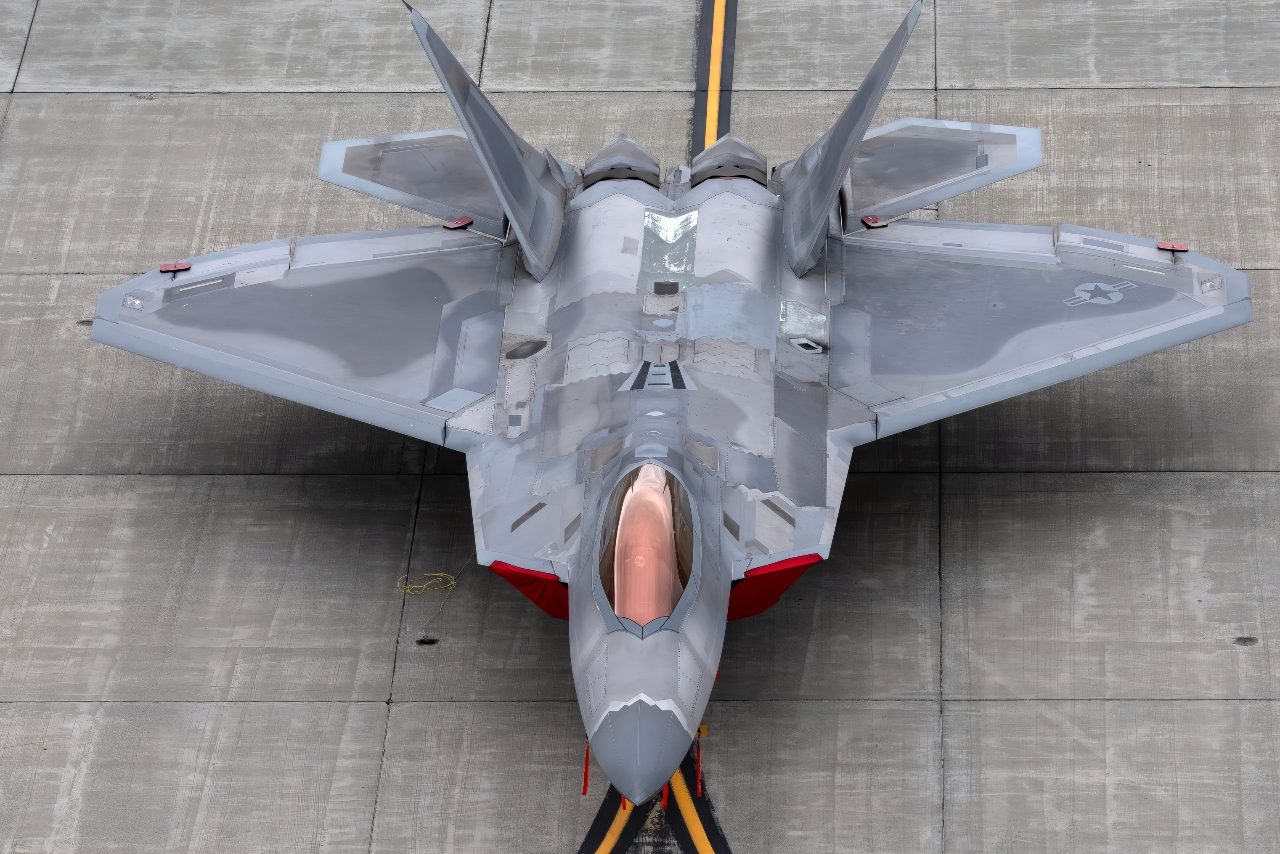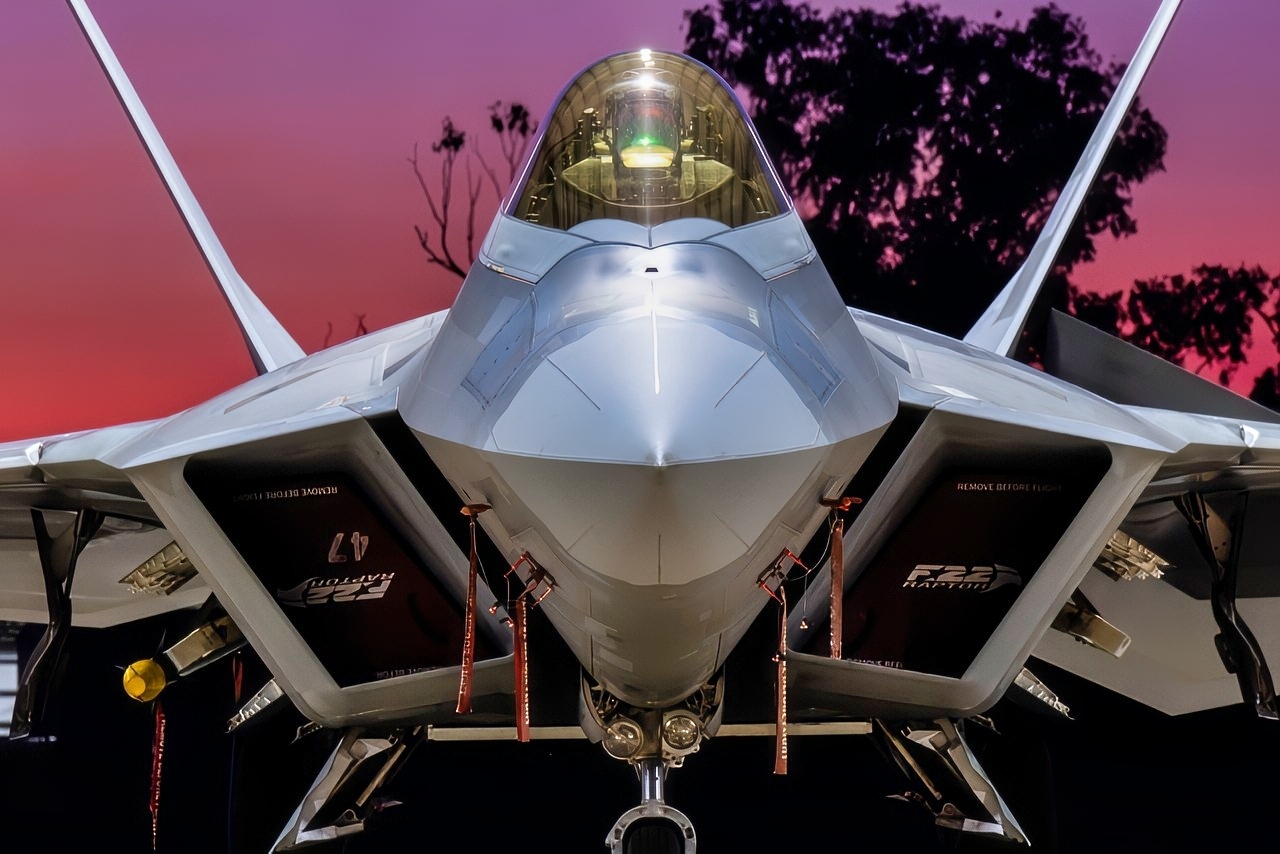Key Points and Summary – With China’s J-20 appearing in larger numbers, the big question is whether it could beat an F-22 one-on-one.
-The Raptor still holds known edges in raw speed (Mach 2.25 vs ~2.0) and thrust-to-weight (~1.37).

A U.S. Air Force F-22 Raptor is displayed on the flight line during a summit between U.S. President Donald J. Trump and Russian President Vladimir Putin at Joint Base Elmendorf-Richardson, Aug. 15, 2025. (Alaska National Guard photo by Seth LaCount)
-China’s latest WS-15 engine reportedly adds supercruise and lifts the J-20 to roughly 1.25, narrowing the gap. A larger radome could host a longer-range AESA, but higher power and emissions risk eroding stealth and inviting jamming.
-The J-20’s bigger airframe trades agility for range and payload; the F-22 favors close-in maneuvering. At distance, outcomes hinge on who sees, jams and shoots first: radar/IRST, sensor fusion and missile reach.
F-22 vs. J-20: The Battle No One Wants to See
As the much-discussed yet still somewhat mysterious Chinese J-20 gains more public visibility and appears in larger numbers, many are likely to re-examine a challenging and “tough to know truly” question: Could the People’s Liberation Army – Air Force J-20 outperform an F-22 in a one-on-one air combat engagement?
While it may seem that there are simply far too many variables and “unknowns” to generate any kind of useful analysis, there are a handful of indicators that may shed some light on the question. An initial and somewhat self-evident consideration is simply pure speed, an area where the F-22 has a known advantage.
The Raptor’s Mach 2.25 is faster than the J-20’s cited speed of Mach 2.0, something which might give the F-22 a slight advantage in the realm of high-speed aerial agility fundamental to dogfighting success.

A U.S. Air Force F-22 Raptor assigned to the 199th Air Expeditionary Squadron sits beneath a hangar as the sun sets in Northern Territory, Australia, July 16, 2025, during Talisman Sabre 2025. Talisman Sabre is the largest bilateral military exercise between Australia and the United States advancing a free and open Indo-Pacific by strengthening relationships and interoperability among key allies and partners, while enhancing our collective capabilities to respond to a wide array of potential security concerns. (U.S. Air Force photo by Senior Airman Natalie Doan)
However, longer-range sensing, AESA detection, engine thrust vectoring ability, and weapons reach could mitigate this advantage, should the J-20 operate with advantages in these areas.
J-20 WS-15 Engine
In recent years, the PLA has written regularly in its state-backed newspapers about its domestically-built J-20 engine upgrades, which, unlike the early J-20 Russian-engineered engines, are indigenously designed and built in China.
The latest J-20 engine model from 2022, called the Shenyang WS-15, is said to introduce new levels of engine-enabled thrust vectoring and bring F-22-like Supercruise technology, according to an interesting 2022 article in the South China Morning Post.
Supercruise is, of course, known as the ability to sustain Mach 2 speeds without needing a high-powered, fuel-consuming afterburner, something that greatly extends any ability to maneuver and vector in air combat for more extended periods of time. Mach 2 speed, sustained without afterburner, supports sustained high speeds for longer without needing to refuel.
Thrust to Weight Ratio
The most significant impact of improvements to the WS-15 likely pertains to thrust-to-weight ratio, which has a clear and decisive effect on a jet’s agility in air combat. High-powered thrust combined with a lighter overall weight naturally increases speed, maneuverability, and sheer dogfighting prowess.
The F-22 with “round nozzles” is reported to operate with a thrust-to-weight ratio of 1.37, the best in the world according to World Defence. However, an October 2024 article from Aviation Geek Club states that the WS-15 improves the thrust-to-weight ratio of the J-20 to 1.25, making it more competitive with an F-22.
Perhaps the ultimate margin of distance would pertain to more difficult-to-discriminate variables, such as the ability to see, detect, and target an enemy fighter jet.
The J-20 has a larger nose radome compared with the pointier front of an F-22, something that might suggest it has a more powerful, longer-range AESA radar. This question is explored in great detail in an academic paper published by National Defense University called “A Look at China’s J-20 AESA Radar,” The NDU “Air University” research explores the question as to whether the J-20 AESA radar is larger due the larger nose radome and “packaged” with more transmit-receive modules (T/R Modules) capable of detecting a target from longer ranges than an F-22.

Aircraft from the 1st Fighter Wing conducted an Elephant Walk at Langley Air Force Base, Jan. 31, 2025, showcasing the wing’s readiness and operational agility. This demonstration highlighted the wing’s capability to mobilize forces rapidly in high-stress scenarios. The wing’s fleet includes F-22 Raptors and T-38 Talons. As Air Combat Command’s lead wing, the 1 FW maintains unparalleled combat readiness to ensure national defense at a moment’s notice. (U.S. Air Force photo by SrA Ian Sullens)
A larger nose radome and more high-powered RF radar signals, however, are not only less stealthy but also more vulnerable to being “jammed.” More power density packaged into a nose radome AESA would also likely emit a stronger and more detectable heat signature, something which would clearly compromise stealth effectiveness.
Therefore, even if the J-20s’ AESA are longer range, it might not translate into a one-on-one aerial combat advantage in closer proximity.
Weight and Size
Overall weight and size are critical to this equation, and the J-20 is 7ft longer and arguably less agile and stealthy. While the empty weight of an F-22 is roughly 6,000 pounds heavier, it appears capable of operating with a superior thrust-to-weight ratio.
Due to this, a closer-in air-to-air engagement would favor an F-22, depending upon weapons range and accuracy, targeting sensor fidelity, computing, and aerial fire control.

J-20 Stealth Fighter in China. Image Credit: PLAAF.
There are also the easy-to-overlook simple questions of weapons range and targeting efficiency. A fighter jet with enhanced sensing and course-correcting capabilities, along with re-targetable long-range air-to-air missiles, would seem better positioned to prevail, as it could “hit” and “destroy” an enemy jet at standoff distances where it cannot itself be targeted.
The J-20 is cited as having an F-35-like EOTS, or electro-optical targeting system, and IRST for infrared search and track. The individual components of these sensing and targeting technologies, and their respective capabilities, would likely heavily impact the outcome of any J-20 vs. F-22 air engagement.
About the Author: Kris Osborn
Kris Osborn is the President of Warrior Maven – Center for Military Modernization. Osborn previously served at the Pentagon as a highly qualified expert in the Office of the Assistant Secretary of the Army—Acquisition, Logistics & Technology. Osborn has also worked as an anchor and on-air military specialist at national TV networks. He has appeared as a guest military expert on Fox News, MSNBC, The Military Channel, and The History Channel. He also has a Masters Degree in Comparative Literature from Columbia University.
More Military
China’s New H-20 Stealth Bomber Is Coming
The Japan-China Senkaku Islands War of 2025: Who Would Win?
The J-20 Stealth Fighter Bomb Truck: What We Know










